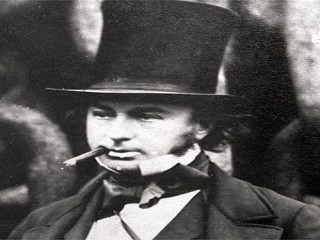
Isambard Kingdom Brunel biography
Date of birth : 1806-04-09
Date of death : 1859-09-15
Birthplace : Portsmouth, England
Nationality : English
Category : Arhitecture and Engineering
Last modified : 2011-07-01
Credited as : Civil engineer, dockyards and bridges, The Great Eastern
Isambard Kingdom Brunel was born on April 9, 1806, near Portsmouth, the only son of Marc Isambard Brunel, known for his machine for making ships' blocks and as the engineer of the Thames Tunnel. After attending the College Henri Quatre in Paris, Brunel served a short apprenticeship under the Paris instrument maker Louis Breguet. Brunel returned to London in 1822 and entered his father's office in 1823, where he received practical training by assisting with the Thames Tunnel until 1828.
Brunel's first important commission was the 630-foot-span Clifton suspension bridge near Bristol (1831). Unfinished in his lifetime, it was completed in 1864 as his memorial. He also built the Hungerford (London) suspension bridge (1841-1845); its wrought-iron chains were used to complete the bridge at Clifton.
In 1833 Brunel was appointed engineer for the Great Western Railway and began surveys for a line between Bristol and London. Construction of the line (1835-1841) included the famous flat-arch bridge over the Thames at Maidenhead and the 3,200-yard Box Tunnel outside Bath (through which the sun is said to shine on Brunel's birthday). With the aim of smooth, high-speed running and locomotive-fuel economy for the line, he introduced the 7-foot gage, which, while technically sound, was commercial folly. However, it was not entirely superseded by the British standard 4-foot 8 1/2-inch gage until 1892. He also designed railroad terminals and a series of bridges, culminating in the Royal Albert Bridge near Plymouth (1853-1859), which combines a tubular arch with suspension chains in the two main spans.
In 1835 Brunel suggested, half in jest, a transatlantic steamship service. The idea found support, and the outcome was the Great Western, a timber-built paddle steamer of 2,300 tons' displacement. In April 1838 it steamed from Bristol to New York in 15 days and then maintained a regular service. His Great Britain (1839-1845) was a 3,600-ton iron-hulled, screw-driven steamship. Brunel's last great ship was the Great Eastern (1854-1859), for which he was the sole architect. Displacing 32,000 tons, the largest ship afloat, it was intended to make the round trip to Australia without recoaling. The Great Eastern had a double hull, and with engines to drive both paddles and screw, it had outstanding maneuverability. That its cost was excessive, its completion delayed, and the launch difficult was largely due to the machinations of the building contractor. Brunel never saw the trials, for he suffered a stroke and died on Sept. 15, 1859, in London. A liability to its owners, the ship showed twice the calculated fuel consumption. The Great Eastern was sold and eventually used to lay the first Atlantic telegraph cable (1865-1866).
Designer :
Bishops Road Canal Bridge (1838)
Chepstow Railway Bridge (1852)
Clifton Suspension Bridge (1864)
Great Western Railway Bridge (1849)
Hungerford Bridge (1845)
Landore Viaduct (1850)
Maidenhead Bridge (1838)
Paddington Station (1854)
Pump House Bridge
Royal Albert Bridge (1859)
Temple Meads Station (1841)
Resident engineer :
Thames Tunnel (1841)
















